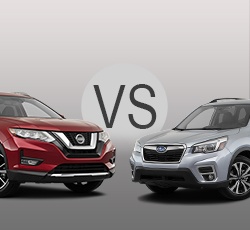2020 Nissan Rogue vs Subaru Forester
Are you looking for a small SUV that can offer you a lot of space? If so, you might be interested in reading about both the 2020 Nissan Rogue and the 2020 Subaru Forester. Both vehicles have plenty of space in their cabins and cargo areas, and they each come loaded up on standard safety features and driver aids. But is one of them actually a better vehicle than the other?
The short answer: Yes. But, of course, you are investing a lot of hard-earned money into a new vehicle, so you require a long answer. That is why we recommend you read this comparison review all the way through to the end. We will cover everything from the vehicles' powertrains to drivability factors, comfort and interior design elements to technology and safety reviews and ratings. By the end, we will let you know which one offers the most value and is the better buy.
Of course, both vehicles have a lot of pros and cons which we will go over in detail. For example, the 2020 Subaru Forester comes with standard all-wheel drive (referred to from here on out as AWD) while the 2020 Nissan Rogue has standard front-wheel drive (or FWD for short) with AWD as an option. The Forester is an excellent off-roader due to its ground clearance, but its tow rating limits are kind of modest. Both suffer from under-powered engines, and the Rogue makes matters worse with an outdated touchscreen, snooze-fest of an interior, and poor rear-view visibility.
Now that you know a little about what to expect from this review, let's get right into the details.
The Powertrain
Time to get things started by discussing the powertrains. First up is the 2020 Subaru Forester. It receives its power from a 2.5-L 4-cylinder engine that is paired up with a continuously variable automatic transmission (CVT). Together, this powertrain puts forth 182 hp and 176 lb-ft of torque. As already mentioned, AWD is standard since, well, that is just what Subaru does for all of its vehicles.
On the other hand, you get standard FWD on the 2020 Nissan Rogue, although each of its three trim levels can be equipped with AWD - for an extra cost. This vehicle is powered by a 2.5-L 4-cylinder engine with a CVT equipped, getting the vehicle 170 hp and 175 lb-ft of torque.
Drivability
Drivability is not just about how powerful a vehicle is, but that is one part of the equation. Comfort, interior design and materials, technology features and their functionality, and how utility-based these vehicles are all factor in to what makes them drive-able. With that being said, let us get started by comparing drivability factors.
The 2020 Nissan Rogue is up for examination first. Unfortunately, we have to start things off on a sour note since the standard engine is severely underwhelming in terms of performance. This engine almost never serves up enough power for you to really accelerate, especially when you are trying to merge or pass someone else on the highway. The slow transmission does not help matters, and the three drive modes (Normal, Eco, and Sport) actually can make it worse. The brakes deliver a normally smooth performance, but they get too soft when you have to make a panic stop - enough to inspire some worry in the driver. Handling is not terrible but is also nothing to write home about, and the steering lacks precision and feedback.
The trade-off? Comfort. Comfort is something that Nissan does exceedingly well. The Rogue remains composed on all types of road surfaces, and when you hit bumps on a rougher road surface, you won't feel them. Very little in the way of wind, road, or engine noise gets in, and the comfy front seats are perfect for long rides. The rear seats might be positioned a little too high off the floor, but they still pack in a ton of comfort.
The cabin itself is pretty spacious, easily fitting four adults. The rear seats can slide forward and backward, which makes finding more leg room easy when needed. The wide door openings make for a hassle-free entry and exit from the vehicle. The driver will have some difficulty finding a good driving position due to the limited number of adjustments the front seat features. You also won't get a very clear view out of the back thanks to the bulky roof pillars and smaller glass. This makes it easy for you to lose sight of a vehicle that is lingering in a blind spot.
Technology could be a lot better. The Bose sound system sounds fine until you crank it up. The bass will cause the speaker enclosures to vibrate when you turn up the volume. Also, voice control fails to recognize natural speech patterns, so you will have to suffer through learning very strict command sequences. Navigation works well enough, but you will have to view its controls on a too-small display and struggle to push the tiny buttons as you drive.
Utility is another highlight on the Rogue. Its 39.3 cubic feet of cargo space is one of the best in this class, and the low load height and multi-configurable floor covers mean you get a ton of versatility. You just won't find many sizable small item storage areas inside of the cabin. The LATCH system is simple enough to use since the seat anchors are actually exposed. However, the upholstery around it is really firm, making it difficult to push on the safety seat buckle. Still, you do not need to remove the cargo cover in order to reach the rear tether strap anchors, which is helpful.
So, how does the 2020 Subaru Forester compare to the Rogue? Let's dive right in.
The Forester is plagued by a lackluster performance from its 4-cylinder engine, coming in with a sluggish 0-60 mph time of 9.3 seconds. Others in this segment do better. This vehicle needs time to get up to speed, so merging and passing are complicated highway procedures. The vehicle does not feel sporty, but it is definitely sturdy and will change direction in prompt fashion. The 8.7 inches of ground clearance - coupled with standard AWD - means you can feel comfortable taking it off of the beaten path. It's a Subaru, so it can handle a jostle about on a back road.
Comfort is mostly good on the Forester. The front seats are well bolstered and padded with plenty of lateral and lumbar support. The suspension can smooth out any bump. You will not hear much road noise, but the vehicle's tall stature does mean that there will be some wind noise, but it is not that intrusive. The high height means you get a commanding outward view, so it is a minor trade-off. The climate control knob is easily within the driver's reach, and the optional automatic climate control system that comes on the higher trim levels gives you heated front and rear outboard seats.
The interior of the Forester is laid out in a sensible, straightforward manner. All controls are labeled and placed within reach of the driver, and the 8-inch touchscreen gives you crystal-clear graphic quality. Navigation is easy to use, and the rear-view images are clearly displayed too. Getting in and out is simple thanks to the tall doors and SUV-like ride height. You can seat five adults in this vehicle without a problem. The front seats are both highly adjustable, which boosts everyone's comfort levels.
Technology is above average in the Forester and is a lot better than what you get in the Rogue. The dual touchscreen layout is quick to navigate, and the navigation system has voice command that understands natural speech patterns. Smartphone app integration via Android Auto and Apple CarPlay is standard, and there are a ton of USB ports up front and in the rear.
Utility falls short of what you get in competitors like Honda but is good nonetheless. you can load up large items and still see out the rear due to the high ride height. The LATCH system has anchors buried within the seat cushions, so you will have to do some digging in order to get to them. Rear-facing car seats can also make things feel a little cramped.
To avoid overpaying on a new car, shop prices online first. Get up front pricing before you walk into a dealership. We recommend the following free services; Car Clearance Deals, NADAguides, CarsDirect & & Motortrend.
These free services will offer you the lowest prices and supply you with multiple competing price quotes. You will know the best price before you visit the dealer.
Safety
Safety is a serious factor to consider when buying a new vehicle. A lot of consumers will check out the latest safety features, but knowing how the National Highway Traffic Safety Administration (more commonly referred to as its acronym, NHTSA) and the Insurance Institute for Highway Safety (also known as IIHS) rate this vehicles is also important.
The 2020 Nissan Rogue comes with ProPilot Assist, a bundle of driver aids that helps keep you safer on the road. Adaptive cruise control works well at smoothly applying the brakes or speeding you up to match the current traffic conditions. Steering assist is a bit obnoxious though as it might stay active even after you have disabled it. Lane departure warning can be overly sensitive but can be effectively turned off as needed.
NHTSA gave the Rogue 4 out of 5 stars overall. It received 4 stars on the overall front crash test, 3 stars on the front driver crash test, 4 on the front passenger, and 4 for the rollover test. While no recalls exist at the time of writing this review, consumers are making complaints about the panoramic sunroof suddenly exploding on them while they were driving along the highway. The IIHS gave it mostly "Good" ("G") marks, but it got "Acceptable" ("A") ranks on the small overlap front passenger side, headlights on the higher trim level, and on the LATCH system. The lower trim levels' lights received "Poor" ("P") for showing excessive glare.
The 2020 Subaru Forester performs a bit better in terms of safety. It comes with Subaru Eyesight, a bundle of driver aids that gives you lane centering with lane keep assist, adaptive cruise control, and forward collision warning (which is known to act quite rapidly).
The NHTSA gave the Forester 5 stars overall, and it only lost one star on the rollover test. The IIHS named it a 2020 Top Safety Pick Plus, giving it "G" marks on all but the Sport's LED projector beam headlights for inadequate visibility on sharp left and right curves.
Which Has the Best Value
Value-wise, the 2020 Subaru Forester gets the edge over the 2020 Nissan Rogue. The Rogue has an EPA estimate of 27 mpg combined (with 25 mpg in the city and 32 mpg on the highway). However, these numbers are lower in real world tests with highway mpg coming in at about 27-28 mpg. The competition is a lot nicer overall. The safety ratings are concerning, and there are a lot of hard plastics within even the top trim level that make the vehicle feel cheap and tacky. The only good things are the comfort level and abundance of driver aids.
The Forester is the clear winner, and here is why: The five trim levels have a ton of options to help you configure it how you want. While the warranty is average, safety scores are high, and you get a massive list of standard safety and infotainment features for the price. The Forester is also known for its customer satisfaction and long history of reliability.
Which is Better?
The winner here is, of course, the 2020 Subaru Forester. It has excellent safety ratings and a bunch of standard features. You can also opt for a lot of nice extras without taking the cost sky-high. While the Rogue is a vehicle that dealers will likely negotiate on in order to sell it, the price does not match the low build quality and poor safety ratings. Do yourself (and your occupants) a favor and consider the Forester. It is a decision you will likely be content with at the very least.

Get up to 4 local dealers to compete for your business by offering free, competitive pricing. Know before you go to the dealer.
Every dealer offers a secret price. Find yours here.
In Depth 2020 Nissan Rogue Comparison Guides:
• 2020 Nissan Rogue vs Rogue Sport
• 2020 Nissan Rogue vs Toyota RAV4
• 2020 Nissan Rogue vs Honda CR-V
• 2020 Nissan Rogue vs Ford Escape
• 2020 Nissan Rogue vs Hyundai Santa Fe
• 2020 Nissan Rogue vs Mazda CX-5
• 2020 Nissan Rogue vs Hyundai Tucson


